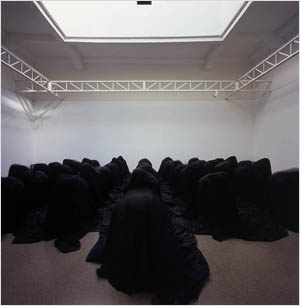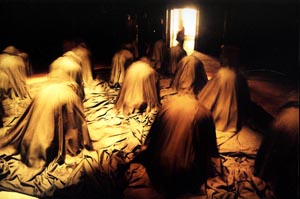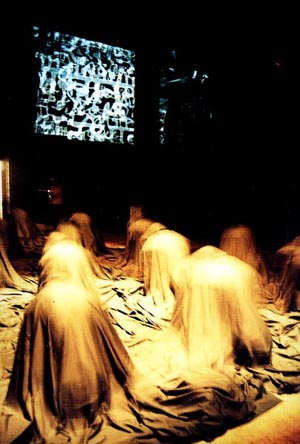
49. Venice Biennale
Russian Pavilion
View of installation
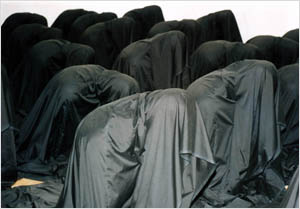
Synopsis II-Theologies
National Museum of Contemporary Art
Athens, 2002-2003
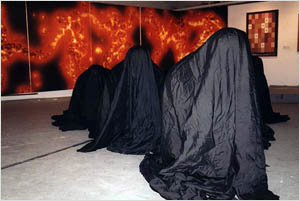
National Center for Contemporary Art, Moscow
2004
Abacus
2001
installation/object
This project was presented at the Russian pavilion of the 49. art exhibition of the Venice Biennale, 9.06-4.11.2001; Synopsis II-Theologies, National Museum of contemporary art, Athens, Greece, 15.10.2002 - 7.01.2003; From the Venice Biennial 2001, Charlottenborg Udstillingsbygning, Copenhagen, Danmark, 21.06-18.08.2002; within Moscow Breakthrough festival - ABACUS, Wapping Project, London, 21.11-30.11.2005; RUSSIA!, Guggenheim Bilbao, Spain, 28.03-3.09.2006; Festival of North Norway, Harstad, Norway, 23.06-30.06.2007
Alien reconciliation
General international attitude to Russia has for many centuries been a mixture of fear and curiosity. Both feelings refer to the same issue - the unknown, mysterious, unclear and hardly understandable nature of the nation that inhabits the gigantic territory between Europe and Asia, belonging and at the same time being alien to both.
This broad statement also applies to the Russian culture and particularly to the Russian contemporary art. To put it roughly the contemporary Russian art may seem - and often is seen by the international art world - as developing in two ways. (This means not necessarily the theme, language, theoretic background or imagery, but first and foremost a modus operandi, and to a great extent modus vivendi). One way is quite internal and hermetic, referring to domestic issues and values, and thus hardly understood by the rest of the world, if recognized at all. Let me say, it was - and somehow still is -untranslatable, because of being to much dependent on Russian cultural specifics, mostly literature-bound, sometimes even fixed on it. Another way might be called Western-oriented, almost in the same extent hardly recognizable at home in Russia, operating with the "imported" discourse. Despite the many brilliant ideas and personalities that these two approaches have brought, both faced a certain problem: the first one being alienated from the world art context, the second one from the Russian culture.
Sergei Shutov is quite a rare figure in Russian contemporary art. He has been a member of various artistic unions, intiatives and stuff like that, but he was and still is very different from the rest. He made videos, drawings, paintings, objects and installations inhabited by techno creatures, moons, robots and rockets since the late 80s. His interests - from Star Wars to tribal music and astronomy - seemed strange to his colleagues at the time, only to become generally recognized years later. Shutov is neither a public animal, nor is he making career with "fashionable" themes. I would say that he is sort of alien in Russian contemporary art, though the kind one who wants to share his knowledge with humans, yet not always to be accepted.
Abacus, the Shutov's project in Russian pavilion is a new - and one of the few - approach in Russian contemporary art, with a message thought over in Russian and distinctly spoken out in the internationally understandable language. It brings out the universally recognized visual statement, which is simple yet multidimensional. Figures on their bent knees saying prayers in various languages appeal to people of different cultures and faiths, should they seem monks, jedi warriors or druids. Although there is an understanding that religions and beliefs address to the most universal things all people share (whenever they speak to Christ, Buddha, Allah or Krishna in Russian, Arabic, Tibetan, Italian or Hebrew), they also divide people - the paradox that humankind has faces throughout its history. Certain belief gives a human being the encouraging sense of identity and belonging (to God, community, universe) which at the same time alienates the one from the others of a different faith - no matter how tolerant these beliefs are and how similar is the apprehension of the basic ideas of happiness and salvation, good and evil, life and death. Placing the praying figures in even rows, as beads on the rods of an ancient abacus, Sergei Shutov brings alienated and even confronting confessions together, with every word they say, every breath they take and every move they make. This work may seem controversial, or provocative - which it is - but it's intention is rather a conciliatory one. And it's more than just a socially driven ecumenist vision of peaceful coexistence of religions. It is the image of humanity brought to where it belongs -face to face with the Absolute.
(Sergei Khripoun)
Synopsis II-Theologies, National Museum of Contemporary Art, Athens, October 15, 2002 - Jamuary 7, 2003
(press-release)
The National Museum of Contemporary Art organises an exhibition entitled "Synopsis II - Theologies". The aim of the exhibition, sequel of the previous one, entitled "Synopsis I - Communicatios", is to highlight, in a synoptic way, the essential aspects of modern art by presenting works of the recent greek and world production.
The first "Synopsis" examines the influence of the technology of new media (video, computer and the Internet) the communicative function of electronic art during the production of the work and its reception by the viewer.
The second "Synopsis" deals with the relations between modern art, the celestial - with its wide meaning - and the religious phenomenon - as special biome, doctrine, worship and power. Excluding the limited and formalist interest of some historian, such as Malevich, Kadinsky, Matis and posteriorly Rothko), in religious spirituality and art, it is the first time that artists are attracted by the anthropologic depth, the intercultural width and the transcendental, secret and erotic experience of religions.
This interest is appreciated in the vista of globalization and consists its positive aspect as it involves the richness of religions, common for humanity. It is served by the dominant comparative religious study, it extirpates contrariness and hatred between different religious practices or heresies and concilliates peak technology with profound religious experience. Most importantly, it critisizes, often sharply, the social and political power of religious hierarchies.
The multiplicity of the artistic approaches is reflected in the use of the term "theologies" - the title of the exhibition. The adoptation of a pure religious term of greek-christian origins, used in plural (theologies instead of theology), indicates the numerous and different Logos on God or gods. Which god or gods do these works - indirectly and insinuatively - talk about and which exactly concepts, metaphors and experiences they invest on are two of the questions to be answered.
The exhibition includes 12 works (installations, video-installations, sculptures) of 13 artists, such as Dimitris Alithinos, Marios Spiliopoulos, Ghada Amer, Diane Gromala and Yacov Sharir, Mariko Mori, Shirin Neshat, Egle Rakauskaite, Bill Viola, Maaria Wirkkala, Sergei Shutov, Jalal Toufic and Vadim Zakharov. The work entitled "Saint John of the Cross" (1983) by Bill Viola, that gives the feeling of the Sublime and expresses the secret erotic experience, can be considered as divinatory. The rest of the works, created during the last years or on the spot for the needs of the exhibition, answer to the previous questions through four main ways: the mystic-spiritual (Viola, Mori, Spiliopoulos, Gromala and Sharir), the sociological (Amer, Neshat, Rakauskaite), the inter-cultural (Wirkkala, Shutov, Alithinos) and the critic-philosophical (Zakharov, Toufic).
